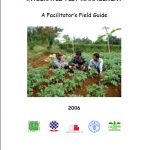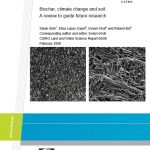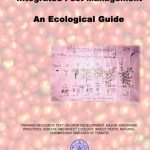16 downloads
Title of document: Effect of Integrated Rice-Duck Farming on Rice Yield, Farm Productivity and Rice-Provisioning Ability of Farmers Authors: Shaikh Tanveer Hossain, Hideki Sugimoto, Gazi Jashim Uddin Ahmed, Md. Rafiqul Islam Journal’s name if any: Asian Journal of Agriculture and Development, Vol. 2, No. 1 Ministry/Government Agency/Organisation: Ehime University, Bangladesh Rice Research Institute, Bangladesh, AJAD Year of publication: Geographic focus: Bangladesh Main issues / topics addressed (for example: Introduction; Materials and Methods; Results and Discussion; Conclusion……) School of agroecology (if any): Web address to original document (if any): Summary: The feasibility of the rice-duck system of rice production, practiced in some East Asian countries, is studied in Bangladesh as a sub-project of the Poverty Elimination Through Rice Research Assistance (PETRRA). The Bangladesh Rice Research Institute (BRRI) implements the sub-project in collaboration with two NGOs, FIVDB and BDS, in the northeastern (greater Sylhet) and southern (Barisal) regions of the country. Each demonstration trial, conducted in the field of the farmers, is treated as a replication. In these trials, the rice-duck system is compared with the methods of growing rice solely, as traditionally practiced by the farmers in Bangladesh. Evaluation of the activities carried out under the PETRRA sub-project shows that the rice-duck system is not only feasible, but also economically rewarding for the farmers. The yield of rice is, on average, 20% higher in the rice-duck system than the traditional rice system (sole rice), thereby ensuring about 50% higher net return and rice-provisioning ability. The ducks in the rice-duck fields control weeds and insects very effectively; as a consequence, labor and pesticide costs for controlling weeds and insects are minimized and the soil health is improved. The ducks provide another source of added income for the farmers. In view of the favorable results obtained in the study, it might be suggested that the rice-duck system be spread throughout the country as an income-generating activity for the resource-poor farmers. Read More

74 downloads
Title of document: Farmer Field School for Tomato Intergraded Pest Management “A Facilitator’s Field Guide” Authors: Sri Wahyuning (LPTP), Warsito Tantowijoyo (CIP), Elske van de Fliert (FAO) Journal’s name if any: Ministry/Government Agency/Organisation: LPTP, CIP, FAO, World Education Year of publication: 2006 Geographic focus: South and Southeast Asia Main issues / topics addressed (for example: Potato Crop Cultivation; Pest and Disease Management; Fertilizers; Pesticides; Harvest and Post- Harvest Management……) School of agroecology (if any): Web address to original document (if any): Summary: This guide is meant as a reference for IPM FFS facilitators. It describes exercises for the farmer field school learning process relating to sustainable potato cultivation. This learning process begins with preparing fields for planting and goes on right up to marketing harvest produce. These experiential learning exercises are intended to empower farmers to become agroecosystem managers through enhancing both their understanding of technical aspects of potato IPM and their decision making and experimental skills. This field guide with learning exercises is closely linked to the potato ecological production guide “ All about Potatoes: A Handbook to the Ecology and Integrated Management of Potato ”. Elaborations on the technical content of the learning exercises in this guide can be found in the respective chapters of the ecological production guide. Potato IPM FFS facilitators should master the contents of both guides. Read More

9 downloads
Title of document: Biochar, climate change and soil: A review to guide future research Authors: Saran Sohi, Elisa Lopez-Capel, Evelyn Krull and Roland Bol Journal’s name if any: Ministry/Government Agency/Organisation: CSIRO, ROTHAMSTED Research, Newcastle University Year of publication: 2009 Geographic focus: General Main issues / topics addressed (for example: What is biochar?; Biochar application in Agriculture; Policy context and Analysis; Research Priorities and Future Challenges……) School of agroecology (if any): Web address to original document (if any): Summary: Biochar is the charred by-product of biomass pyrolysis, the heating of plant-derived material in the absence of oxygen in order to capture combustible gases. The objective of this report was to review and evaluate published studies with regard to what evidence and arguments currently exist that assess the application of biochar to soil to a) sequester carbon and b) produce secondary agronomic benefits. Current analyses suggest that there is global potential for annual sequestration of atmospheric CO2 at the billion-tonne scale (109 t yr-1) within 30 years. So far, however, the underlying published evidence arises mainly from small-scale studies that do not currently support generalisation to all locations and all types of biochar. Read More

26 downloads
Title of document: Tomato-Integrated Pest Management: An Ecological Guide Authors: FAO Journal’s name if any: Ministry/Government Agency/Organisation: FAO Year of publication: 2000 Geographic focus: South and South East Asia Main issues / topics addressed (for example: Major Agronomic Practices; Ecology of Insect Pests and Natural Enemies; Major tomato Insect Pests; Major Natural Enemies of Tomato Insect Pests; Disease Ecology; Major Diseases of Tomato; Weed and Rodent Management……) School of agroecology (if any): Web address to original document (if any): Summary: This ecological guide is developed by the FAO Inter-Country Programme for IPM in vegetables in South and Southeast Asia. It is an updated version of the Tomato IPM Ecological Guide dated June 1996. The objective of this ecological guide is to provide general technical background information on tomato production, supplemented with field experiences from the National IPM programmes connected to FAOs Vegetable ICP, and from related organizations active in farmer participatory IPM. Reference is made to exercise protocols developed by Dr. J. Vos of CABI Bioscience (formerly IIBC/CAB International) for FAO. The exercises are described in Vegetable IPM Exercise book, 1998 which contains examples of practical training exercises that complement the technical background information from this guide. Read More
15 downloads
Title of document: Field Guide Exercises for IPM in TOMATOES (Part II) Authors: FAO - IPM Hanoi Journal’s name if any: Ministry/Government Agency/Organisation: FAO, MARD Year of publication: 2008 Geographic focus: Vietnam Main issues / topics addressed (for example: Field Studies; Ecosystem Analysis Questions; Plant Development……) School of agroecology (if any): Web address to original document (if any): Summary: The Field Guide Exercises for IPM in Vegetables was developed through the efforts of the trainers of the Vietnam National Program, members of the National IPM Group and the FAO staff in Hanoi with contributions from the FAO Regional Programme. Some of the exercises were adapted from the Indonesian Field Guide for Rice IPM and the Palawija Exercises. Some were based on activities done in the vegetable project of the Philippine National Program. Read More
7 downloads
Title of document: Dynamics of rice production development in Myanmar: Growth centers, technological changes and driving forces Authors: Masahiko Matsuda Journal’s name if any: Ministry/Government Agency/Organisation: Ritsumeikan University Year of publication: 2009 Geographic focus: Myanmar Main issues / topics addressed (for example: Introduction; methods; Results and discussion……) School of agroecology (if any): Web address to original document (if any): Summary: Rice has been the predominant crop in Myanmar (Burma) for a century and is grown all over the country under various farming systems. The production showed several distinct periods of increase after the country’s independence. The present study focused on the latest developing trend in rice production, with the arm of the characterizing it in the relation to the history of the country. The development processes in Myanmar for the last century were reviewed using statistical data, and three rapid growth phases for rice production were identified: the first in the mid-1970s to early 1980s, the second in the early 1990s, and the third from the late 1990s. Their technological feature and major growth areas are discussed with the framework of agro-ecological zoning, which devices the country for four zones: the delta, costal, central dry and mountainous zones. The rapid growth in the first and second phases was caused by capital and land use intensification, respectively in the delta and central dry zones, which was the political center of the country. In contrast, the third phase has occurred in the mountainous zone, which has been political periphery. Is was also found that, in each of these phases, the growth was driven mainly by the government policy. The latest rice development may imply that the influence of the central government has recently been strengthened and expanded in the mountainous region. Read More
3 downloads
Title of document: Intensification level of rice farming in Myanmar: implication for its sustainable development Authors: Masahiko Matsuda Journal’s name if any: Ministry/Government Agency/Organisation: Springer Year of publication: 2010 Geographic focus: Myanmar Main issues / topics addressed (for example: Introduction; Materials and methods; Results and discussion……) School of agroecology (if any): Web address to original document (if any): Summary: This study aims to estimate the intensification of rice farming in Myanmar particularly due to chemical fertilizer application, using farm-level data obtained from field surveys conducted in the 2000s. Relatively high-input rice farming was found in dry season crop in the delta zone and the double crop in well-irrigated lowlands of the central dry zone. A gap was observed between these calculated values and the official statistics. A comparison of fertilizer use efficiency for rice production in Myanmar with that in China and Vietnam has shown that the efficiency in Myanmar has not declined to an inappropriate level even in its intensive ones. Rice production in Myanmar has room for increasing the yield by capital intensification. Nevertheless, considering its sustainability as well as productivity, further intensification in rice farming technology in irrigated lowlands of Myanmar may neither be the best nor the only way. Read More

11 downloads
Title of document: What place for an agroecological rice technique in rain fed lowland rice systems? - Case study of the SRS in Xieng Khuang Province, Laos Authors: Journal’s name if any: Ministry/Government Agency/Organisation: ISTOM, CTI, GRET Year of publication: 2017 Geographic focus: Lao PDR Main issues / topics addressed (for example: Context of the study of the System of Rice Intensification; Methodological framework and Data collection; Results: Dissemination, adoption and performance of SRS; Discussions and conclusion ……) School of agroecology (if any): Web address to original document (if any): Summary: With the growing concern about food security in the northern part of Laos, it is critical to address the issue of sustainable intensification of food production, especially the staple food: rice. In this context, the presented study is designed to evaluate the performance and sustainability of a recent agro-ecological rice cropping technique, named the Sustainable Rice System (SRS). This innovation, introduced in rain-fed lowland systems, is compared to traditional rice growing practices in the study area of Kham District, Xieng Khuang Province. The conduction of the study goes through the understanding of real diversity of practices, which has the result of a distinction between one-seedling practices, named as SRS, and the multipleseedling practices. Then, the emphasis on the SRS group demonstrates its status in the area as well as the benefits and disadvantages. In order to assess the sustainability of the SRS, the study tries to go beyond only using the “yield” indicator as the “be all and end all”, through the three mainstays dimensions of agro ecology; Social, Economic and Environmental. This shows that, even if the yield is not the primary benefit of the technique, farmers are still interested in adopting it as it provides other benefits. Nevertheless, all of the effects are not positive, and the durability of the technique does not seem to be fully guaranteed. This study therefore introduces many key answers to the questions addressed and presents a first overview to pave the way for following studies. Read More
4 downloads
Title of document: Development in Practice: Commercialising smallholder agricultural production in Lao People’s Democratic Republic Authors: Kim Alexander, Peter Case, Michael Jones and John Connell Journal’s name if any: Ministry/Government Agency/Organisation: Rutledge Year of publication: 2017 Geographic focus: Lao PDR Main issues / topics addressed (for example: Agricultural innovation system: actors and institutions; Methodology; Discussion of agricultural innovation systems; Conclusion ……) School of agroecology (if any): Web address to original document (if any): Summary: Many smallholder farmers in Lao People’s Democratic Republic are transitioning from subsistence to commercial production. This article employs the Agriculture Innovation System (AIS) framework to report on empirical findings from six case studies of Lao smallholder production. It identifies the actors, organisations, and institutions involved in systemic commercialization of subsistence farming and articulates patterns of interactions that contribute to the relative success of the transition. Of the factors identified in the case studies, the most important enablers of commercial production and adoption of innovative technologies were technical and financial assistance, access to markets, and the formation of farmer associations/organisations. Read More
3 downloads
Title of document: Concept Note for NUDP: Learning from Longlan Village Authors: Journal’s name if any: Ministry/Government Agency/Organisation: NUDP Year of publication: Geographic focus: Lao PDR Main issues / topics addressed (for example: an introduction Longlan Village and Why is resilience important; What can NUDP learn from Ban Longlan?……) School of agroecology (if any): Web address to original document (if any): Summary: A short visit to Ban Longlan on the border of Luang Prabang and Phonxai Districts provides an idyllic picture of village life in the mountains of Northern Laos. High above the valley, amid karst peaks and mature forest, the Hmong inhabitants of Longlan appear to have escaped the poverty that affects so many other upland communities. The Northern Upland of Laos, where Ban Longlan is located, have often been characterised as poor and remote. If may be more useful, however, to describe the region as highly diverse and highly dynamic. Ban Longlan is a success story. This is the kind of success that the Northern Upland Development Programme wants to achieve in many other locations. There are unique circumstances behind every story, but there are also lessons that can be applied elsewhere. Read More

 Asia & Mekong Region
Asia & Mekong Region  Cambodia
Cambodia  Laos
Laos  Myanmar
Myanmar  Other
Other  Vietnam
Vietnam